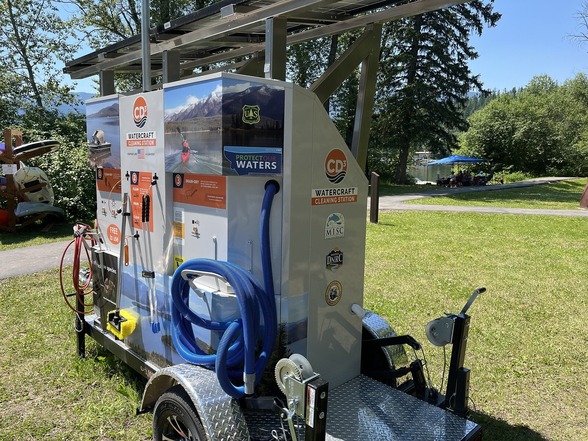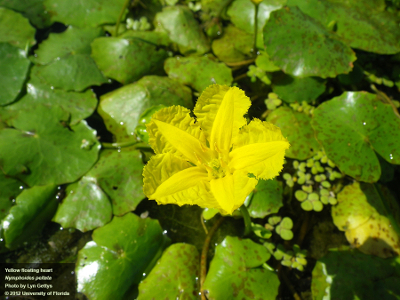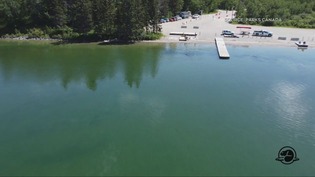|
2024 Montana Invasive Species Summit
The Montana Invasive Species Council is hosting the Montana Invasive Species Summit on November 14 at the Delta Hotel in Helena. This biennial conference brings together agencies, partners and stakeholders to discuss invasive species issues and identify areas to improve invasive species management.
Registration is open for individuals and vendors to attend the Montana Invasive Species Summit.
Consider attending these meetings held at the same location:
- November 12 - MISC Quarterly meeting
- November 13 - Fish, Wildlife & Parks AIS conference
Click below to register!!
Registration Due by November 4th

Woody Invasives Science Advisory Panel
The second Woody Invasives Science Advisory Panel is October 17 in Helena at the Best Western-Capitol Hotel (formerly Jorgenson’s) at 1714 11th Ave.
To register contact Sara Ricklefs at sara@stopais.org
Noxious Weed Trust Fund Grant Applications Now Available
Helena, Mont. – The Montana Department of Agriculture (MDA) announced noxious weed grant funding is now available for the 2025 Noxious Trust Fund (NWTF) Grant Program. Established by the 1985 Montana Legislature, the NWTF grants provide funding for noxious weed research projects, development projects, state and community education, and local cooperative - landowner cost share.
To learn more about these opportunities, please visit the Noxious Weed Trust Fund website or contact Greta Dige, NWTF Program Coordinator, at 444-7882 or greta.dige@mt.gov.
|
|
Forest Service Launches New Self-Serve Cleaning Stations to Combat Aquatic Invaders
Missoula, MT— The U.S. Department of Agriculture, Forest Service in the Northern Region introduced a new tool in the fight against aquatic invasive species through the installation of four waterless, boater-operated cleaning systems.
CD3 system, which stands for clean, drain, dry and dispose, is a standalone watercraft cleaning unit offering an air blower, wet-dry vacuum, hand tools, and lights.
“The Northern Region has world-renowned waterways from Pend Oreille Lake to the Gallatin, Madison and Missouri Rivers, hundreds of lakes, and many headwaters,” said Michelle Cox, Invasive Species Program Manager, Northern Region. “It is critical that we continue to all do our part and look for ways to prevent the introduction and spread of aquatic invasive species into our waterways.”
Boaters can use the tools to remove and properly dispose of water, weeds, debris, and leftover bait to aid in preventing the spread of aquatic invasive species like quagga and zebra mussels, New Zealand mud snails, curly leaf pondweed, and fragrant waterlily.
Cleaning stations are located at:
- Swan Lake, Flathead National Forest
-
Georgetown Lake, Beaverhead-Deerlodge National Forest
- Hebgen Lake, Custer-Gallatin National Forest
-
Priest Lake, Idaho Panhandle National Forest

While the CD3 stations are a valuable tool, all motorized and non-motorized watercraft must still undergo mandatory inspections at designated state inspection sites.
By using the CD3 stations, boaters can help prevent the spread of aquatic invasive species like quagga and zebra mussels, New Zealand mud snails, curly leaf pondweed, and fragrant waterlily. These invasive species wreak havoc on ecosystems, disrupting food webs and damaging infrastructure.
Using Your Phone to Become a Citizen Scientist!
The Natural Heritage Program (NHP) provides a treasure trove of information on Montana's species and habitats. This natural resources data is used daily by government agencies, businesses, nonprofits, and citizens.
With the iNaturalist phone app, you can capture images of the plants and animals around you, identify the species, learn more about them, and submit the observation. Observation are then quality assessed by a large team of experts and added to the NHP databases.
Learn how to use the iNaturalist app and hear some cool stories about how citizen submissions have stopped the spread of invasive weeds and documented rare species. Start capturing pictures today and add to the hundreds of thousands of observations that have been gathered so far.
 Biological Control of Flowering Rush
SUMMARY: We are advising the public that the Animal and Plant Health Inspection Service has prepared an environmental assessment relative to permitting the release of the insect, Bagous nodulosus, for the biological control of flowering rush (Butomus umbellatus) in the continental United States.
Based on the environmental assessment and other relevant data, we have reached a preliminary determination that the release of this control agent within the continental United States will not have a significant impact on the quality of the human environment. We are making the environmental assessment available to the public for review and comment.

Yellow Floating-Heart found in Gallatin County
[Montana] Nymphoides peltata (yellow floating-heart) was found in a private pond [USGS NAS [westernais.us17.list-manage.com].
Initially introduced as an ornamental plant in Canada and the United States, yellow floating heart is an invasive aquatic plant that can produce dense mats of leaves in the form of a floating canopy, which results in reduced flow, reduced light penetration, lower oxygen levels, and altered nutrient cycling of waterways.
|
Invasive species are reshaping aquatic ecosystems, one lake at a time
Freshwater ecosystems in Canada and around the world are under siege.
Lakes, rivers, ponds and wetlands face many environmental threats, but one that is changing them most rapidly is the spread of invasive non-native species.
In recent years, there have been numerous outbreaks of invasive species in Canadian lakes. Zebra mussels continue to spread in Québec and Manitoba. Chinese mystery snails are increasingly found in lakes in eastern Canada. Eurasian watermilfoil has spread to the maritime provinces. Meanwhile, goldfish have become superabundant in small lakes and ponds throughout the country.
Zebra mussels covering rocks on the bottom of Lake Memphremagog, Que. (Brielle Comartin), Author provided (no reuse)

Zebra mussel containment curtain in Clear Lake to be removed after taking damage
A containment curtain meant to help prevent the potential spread of zebra mussels in Clear Lake is going to be removed.
Parks Canada announced Monday the curtain – which was in the water for just over a month – will be removed after it was damaged by strong winds and waves on the lake.
It was originally installed after an adult zebra mussel was found in the part of Clear Lake known as Boat Cove.
The curtain stretched from the cove to the pier and was meant to prevent the spread of the mussel to other parts of the lake. Continue Reading...
|
Arkansas fishermen, officials seek solutions to invasive carp challenges
Nearly 50 years ago, catfish farmers in the Arkansas delta imported Asian carp to clean vegetation from ponds, making better habitats for the lucrative fish crop.
It sounded like good practice. Carp eat nearly their weight each day and the plankton and plants that were detrimental to catfish disappeared. More farms popped up in eastern Arkansas along the Mississippi River and its oxbows. Business thrived.
But in what sounds like a plot from a cheesy 1950s science fiction movie, carp escaped those ponds due to flooding and improper management and got into the Mississippi River. In the 25 years since those first fish found freedom, millions of carp began moving northward up the river, into the Illinois River and now the Chicago River, eating everything they could find and now threatening the sport fishing industry in Lake Michigan.
Zeb Clark, a former Game and Fish invasive carp team member, holds a 69-pound carp taken from the Arkansas River. (Courtesy photo)
|
|

White-Nose Syndrome and Bats
October 16, 2024 @ noon - 1:00 pm
White-Nose Syndrome (WNS) is a devastating disease that affects hibernating bats, caused by the fungus Pseudogymnoascus destructans (Pd). This fungus thrives in cold, dark, and damp environments, attacking the bare skin of bats during their hibernation. In this webinar, we’ll explore the impact of White-Nose Syndrome and learn more about the efforts of the White-Nose Syndrome Response Team to combat this deadly disease.
|
|
Aquatic Invasive Species Training Workshop - Bozeman, MT
 |
Apply for Wild Spotter Invasive Species Ambassador Training Class of 2025
Are you passionate about making a real impact in your natural resource management efforts? This 3-day workshop is your opportunity to gain essential skills and tools to drive on-the-ground action in your local programs and build capacity for long-term community engagement!
When: February 4-6, 2025 Where: Lake Guntersville State Park, Lake Guntersville, Alabama
Whether you're just starting or looking to level up your expertise, this workshop will empower you to bring tangible results to your invasive species management programs.
-
Partnership Building & Stakeholder Engagement: Learn strategies to foster strong partnerships and engage key stakeholders in your programs.
-
Branding & Marketing Expertise: Gain insights on effectively branding and promoting your programs to increase awareness and support.
-
Innovative Tools & Technologies: Master cutting-edge tools and technologies, including the Wild Spotter detection tool, to enhance your impact.
-
Volunteer Citizen-Science Coordination: Learn how to recruit, retain, and coordinate volunteers through citizen-science initiatives.
-
Leadership & Community Action: Develop leadership skills that empower you to mobilize your community toward real, sustainable change.
-
Networking with Experts & Peers: Connect with a skilled team of experts and like-minded peers to exchange ideas, build collaborations, and strengthen your network.
2024 Pest Management Tour offers Credit Opportunities for Private Pesticide Applicators across Southwest Montana
The Montana State University (MSU) Extension Pesticide Education Program (PEP) is offering the 2024 Pest Management Tour for pesticide applicators in Private Applicator Training (PAT) District 2, from October 15th - 18th. The tour will cover eight locations in four days with support from MSU Extension agents. Private applicators may attend the morning or afternoon session for three private applicator credits, or all day for six credits. Commercial applicator credits are also available and can be viewed on the PMT event website [montana.edu].
Figure 1. Montana counties within private applicator district two.
|
|
Research Summary: You take the high road and they’ll take the low road, but non-natives will get there afore ye
Summary: Understanding species’ potential range shifts in response to climate change involves two main components. First, how fast are species able to move (observed spread). Second, how much space does the species have to move into (potential spread). Faster-moving species with larger ranges to expand into have a higher likelihood of surviving in a changing climate. Researchers and practitioners are concerned that non-native species will have an advantage in shifting their ranges with climate change. Bradley et al. (2024) review observed and potential spread of native versus non-native species and show that these concerns are well founded. In terrestrial systems, species need to move an estimated 3.25 km/year just to keep up with the current pace of climate change. Non-native species are spreading at an average rate of 35 km/year, more than 20 times faster than native species. These numbers illustrate that non-native species should have no problem shifting their ranges in response to climate change. In contrast, many native species, particularly slow-moving taxa like plants, will be unable to keep up without help. However, if native species had assistance like non-native species do, many more native species would be likely to persist with climate change.
In addition to spreading much faster, non-native species also appear to have larger potential ranges than native species, giving them more area to expand with climate change. This is likely due to the broader climatic tolerance of non-native (and especially invasive) species as well as their release from natural enemies. Species with large potential ranges currently also tend to have large potential ranges with climate change, which means that they have more area of expansion and more area of contraction. Area of expansion can be interpreted as risk from range-shifting species; area of contraction could create potential for restoration, but the loss of invasive species due to climate change has not yet been documented on the ground. Collectively, this review underscores the clear advantage that non-native species have in a changing climate.
-
Native species, particularly plants, need to move orders of magnitude faster than their current rates to ‘keep up’ with the pace of climate change.
-
Native species moving too slowly is consistent across taxa and across terrestrial, freshwater, and marine systems.
-
Non-native species across taxa and systems are readily keeping pace with climate change, likely due to human-mediated spread combined with faster natural spread rates.
-
Non-native species, particularly plants, tend to have larger ranges and therefore might have more area to expand into with climate change.
-
Most native species need human assistance to expand their ranges.
-
Non-native species, and especially invasive species, tend to have broader climate tolerance and therefore will have larger areas of potential range expansion with climate change.
-
Non-native species also have larger areas of potential range contraction, and restoration opportunities could result from these changes.
|
|
-
Oct 16: AIS Train the Trainer Workshop - Bozeman, MT
- Oct 17: Woody Invasive Working Group Science Advisory Panel - Helena, MT
- Oct 23-24: Western Regional Panel for Aquatic Nuisance Species - Grand Junction, CO
- Nov 12: MISC Quarterly Meeting - Helena, MT
- Nov 13: FWP AIS Conference - Helena, MT
- Nov 14: Montana Invasive Species Summit – Helena, MT
- Nov 19: Wildfires, Climate Change, & Invasive Species Conference - Virtual
- Dec 3-4: Western Weed Coordinating Committee Conference - Boise, ID
- Dec 4-5: 6th Annual Innovations in Invasive Species Management Training – Nashville, TN
- Dec 10-11 - 100th Meridian CRB AIS Team Meeting – Spokane, WA
- Jan 28-30: Montana Weed Control Association Convention - Great Falls, MT
- April 14-17: National Forum on Biological Control Conference – Annapolis, MD
|
|
|
|
|